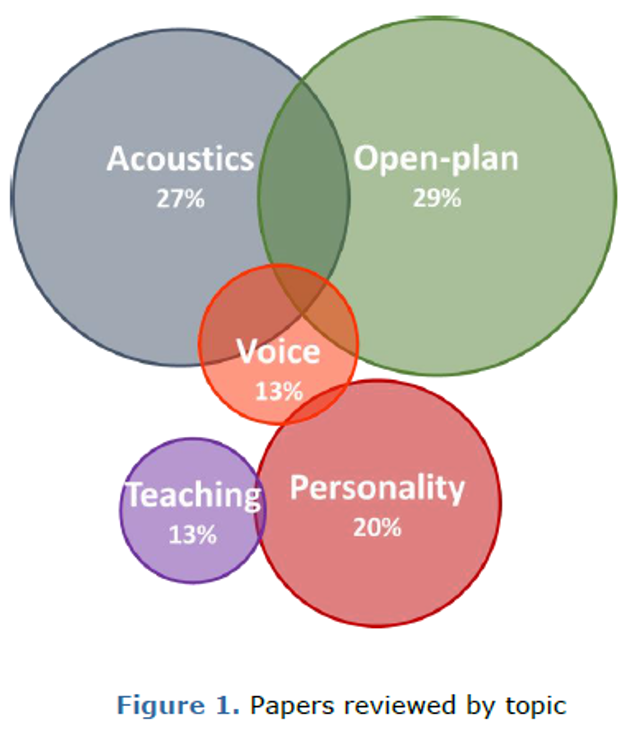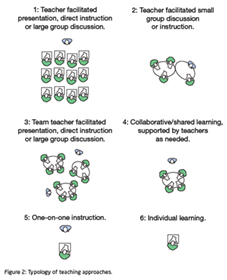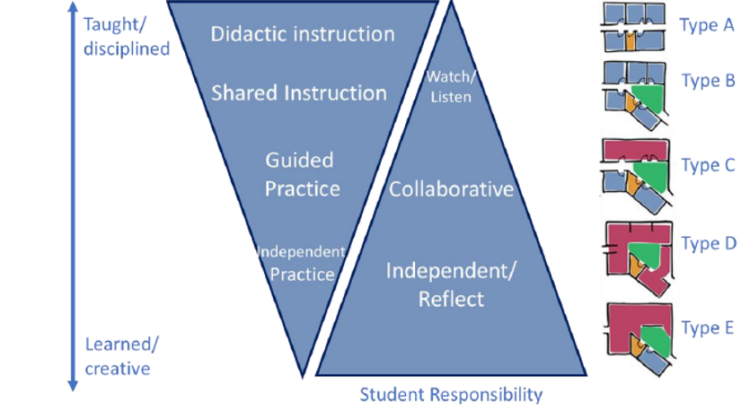
Background to the report
Despite resistance to open plan classrooms in many countries, the movement towards innovative learning environments continues in parts of Europe, especially Scandinavia, Australia and New Zealand. Their definition (ILEs), is an ongoing discussion in itself and their success is dependent on many aspects. However, understanding the changes in pedagogic approaches, including aspects like the profile of teachers in this context and the quality of the design around acoustics is key to informing the design process in order to deliver successful and sustainable learning outcomes.
Ongoing Innovative Learning Environments and Teacher Change* (ILETC) research from the University of Melbourne identifies that deep learning and student fulfilment is most likely to occur in diversified learning activities and broader innovative learning spaces. In response to this, it is now increasingly likely that many schools will be designed or remodeled to reflect this ongoing approach.
The success of a diversified approach to learning and their appropriate spaces is dependent on several factors, but two most commonly affected and often not given enough consideration are the teachers and the acoustic environment.
Introduction to the scope based on a similar acoustics approach in open offices
A new report by Workplace Unlimited is an important addition to existing literature exploring the need for optimal acoustic design, innovative learning environments and teacher change (ILETC)*. This includes an investigation into the research undertaken so far (circa 200 papers) regarding: traditional classrooms, open learning spaces, noise, acoustic related solutions and the potential implications of different teacher personalities.
– In another similar recent study by Workplaces Unlimited around psychoacoustics, related to office noise, it was found that personality affects how well office workers can tolerate noise. (An on-line BFI based** office survey by Oseland & Hodsman was designed***). Based on this it is interesting to look into the case for teachers in classrooms, both traditional and open plan.
This latest educational environments review was aimed at testing several pertinent hypotheses:
- Any identified issues with noise in open plan classrooms can be partially mitigated through design improvements and acoustics solutions.
- A teacher’s personality profile, in particular extroversion, will enable them to better cope with noise in the (open plan) classroom.
- Organisational factors such as teacher training, coordination of the space, timetable administration, changes in pedagogy, and managing student behaviour will help resolve any identified issues with open plan classrooms.
The image to the left shows the proportion of papers reviewed around these topics. Some of the interesting aspects discussed in the report to consider and link up are highlighted in the image to the left.
It is common place now to see the teacher-centric approach move to become increasingly more student-centric. While the teacher addresses the class at the beginning and perhaps periodically during lessons see Figure 3. Typology 1. below) the majority of the time is more likely to consist of more diverse teaching Typologies 2-5 which require the teachers spoken input and coaching but not to the whole class.
So the design of learning spaces needs to support more diversified teaching and learning activities. See the range of Typologies of learning spaces (in Figure 15. below). They start with A. i.e. a traditional enclosed classroom, to classrooms which connect to street spaces, convertible walls and openings, convertible class and street spaces through to larger zoned but open common spaces.
An interesting aspect around teacher change is how teachers can empower the students to take more responsibility, and participate more in their own learning, through engagement and collaboration with the other students and the teacher.
Linking the typologies of teaching activities and spaces
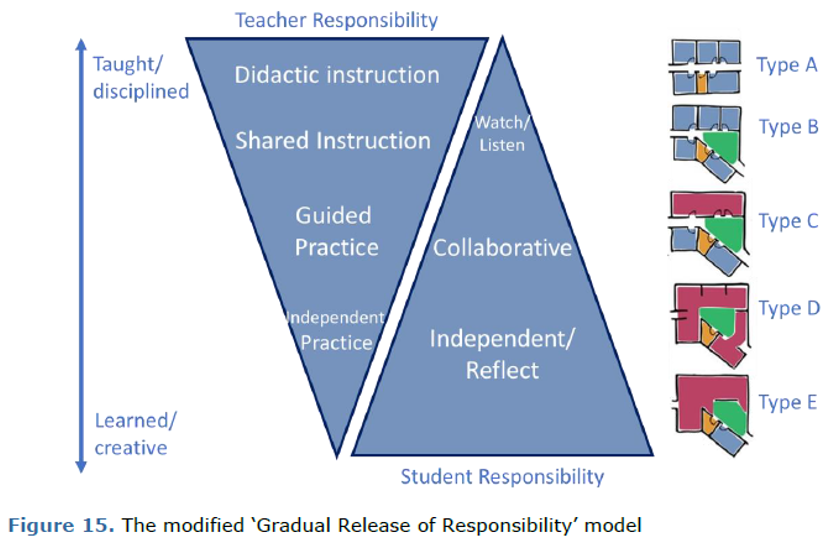
The handover or responsibility from the teacher to the student in the context of the activity while correspondingly relating to appropriate learning spaces down the right. It shows how teaching and learning activities can potentially be more effective in the context of a more diverse use of space.
In order for this to work effectively, everyone in these spaces needs to respect and understand the same approach which must also be supported by the educational vision and leadership approach.
Matching the appropriate activity and space may be one of the keys to understanding how learning spaces can be designed and used.
Acoustic separation of activity zones
Focus is required on zoning and acoustically separating the class bases to minimise disturbance and annoyance between shared spaces. The report finds that the furniture needs to adapt to allow the class to circle closer to the teacher, either by moving or having small purpose made amphitheatres to support close speech communication.
It is always good to cluster the listeners closer to the speaker
An Australian study (Mealings 2015 see diagram below) found that the distance from the teacher was inversely proportional to speech perception.
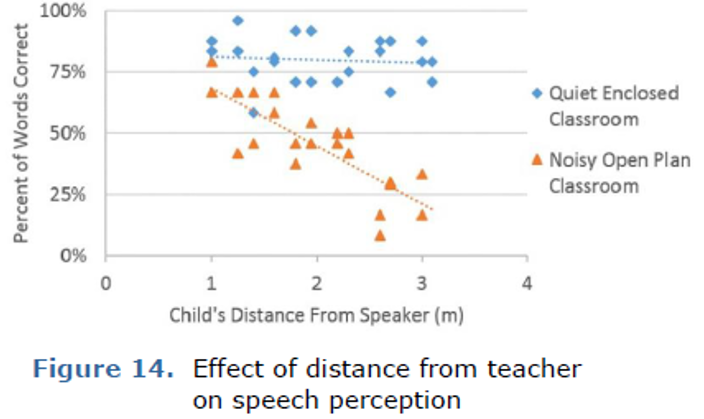
So the closer to the teacher for the formal lecture style (teacher-centric) speech communication the better – students should be gathered close around the teacher and away from openings and direct sound paths to and from other class bases. Thereafter for more informal (student-centric) activities, the students can spread away from the teacher to a variety of other more appropriate learning spaces.
Design tools available focusing on acoustics
There are various tools available to support an understanding around educators needing to collaborate and coordinate learning activities and the appropriate spaces as seen in the UK school design guidance below.
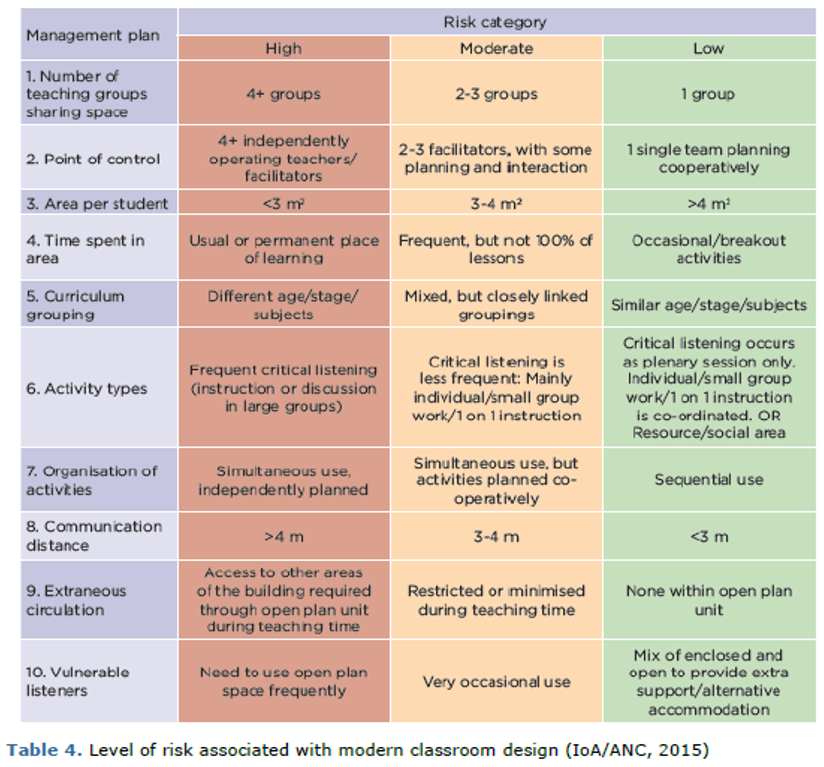
This recommends that “teachers should plan activities between class bases, so that work involving movement is coordinated and does not take place when other class bases are involved in critical listening activities such as whole class teaching.”
Interestingly the New Zealand MoE (2016) concurs and highlights that: “Flexible learning spaces work best when educators collaborate and coordinate learning activities within the space. This can be by effective scheduling of learning activities to avoid clashes between quiet and noisy activities.
In general, the report points to four key open learning space solutions
Innovative learning environments, the modern adaptation of open plan classrooms, are gaining popularity in some countries as they facilitate a change in pedagogy. However, some of these new spaces are less successful, and can result in noise and distraction, due to their design and use. A range of practical solutions can be summarised as below:
- Management – (vision & leadership)
- Layout – (zoning of classes with staggered opening to zones)
- Furniture – (supporting agility or specific activities such as tiered seating)
- Absorption solutions – (reducing noise & disturbance between different activity zones)
The report concludes that despite the introduction of standards, noise distraction in all class spaces appears to be an issue – affecting teacher and student performance. The impact of noise can be exacerbated in ILEs if the teachers do not embrace, or are not trained in the appropriate pedagogic approach and if the class base activities are not coordinated.
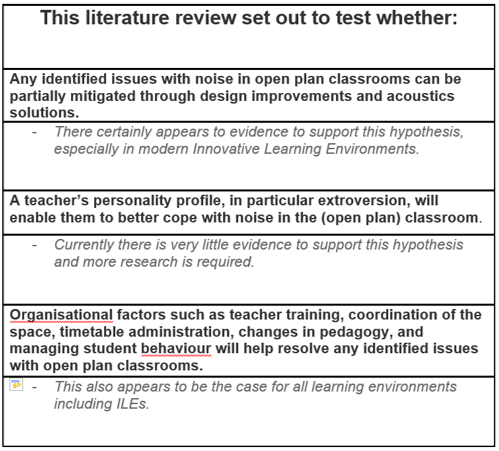
If you would like to read more about this, download the report Open plan teacher personality v3.4.
In addition, you can watch this joint presentation by Nigel Oseland and Colin Campbell from Design & Management of Learning Environments 2018 here during the report development.
https://www.youtube.com/watch?time_continue=2011&v=Xds2mq9EKMM
*Teacher change as defined in the ILETC research project here and their Technical Report No.1 looking into deeper learning outcomes is available here.
**The BFI, developed by Berkeley University (John, Naumann & Soto, 2008), is often referred to as OCEAN because it has five dimensions: Openness, Conscientiousness, Extroversion, Agreeableness and Neuroticism. The BFI is the personality profiling method that was adopted by Ecophon in previous research (Oseland & Hodsman, 2018).
***An on-line BFI based** office survey by Oseland & Hodsman is available here.

